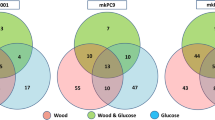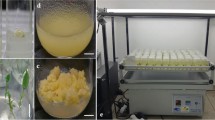Abstract
A WASHED suspension of Bacillus amyloliquefaciens Fukumoto cells1, which is a strain of Bacillus subtilis that has been used for the industrial production of bacterial α-amylase, secretes a small but distinct amount of amylase when shaken aerobically in the presence of phosphate. Under the same conditions, the addition of a sugar or a salt of an organic acid as the carbon source causes a great increase in the formation of amylase without any addition of nitrogen source2. Since the enzyme detected in the autolysate or lysozyme-lysed solution of the bacterial cells is very small, it seems to be certain that the amylase appearing in the cell suspension did not pre-exist in the bacterial cells, but is newly formed and secreted by the cells. In this experiment, however, the amount of enzyme formed differs markedly according to the type of carbon source3. As seen in Table 1, there is no clear adaptive relationship between the formation of enzyme and the carbon sources, and also the amount of amylase formed is not in any way parallel to the respiration activity of the cell, which is related to the carbon sources. This characteristic effect of carbon source on enzyme formation is almost always observed, regardless of the type of carbon source on which the cells are grown. Sugars such as glucose and fructose are not only ineffective but may be even somewhat inhibitory, and adding them to other carbon sources which are available for enzyme formation completely nullifies their effect. This diauxic effect5 appears almost immediately after the addition of these sugars, and remains constant during the course of the experiment, although no metabolic product inhibitory to enzyme formation has yet been detected in the cell suspension system. However, even on a glucose carbon source, good formation of the enzyme occurs to the same extent as from a galactose carbon source, if the glucose concentration is maintained at a very low level (about 0.01–0.02 per cent).
This is a preview of subscription content, access via your institution
Access options
Subscribe to this journal
Receive 51 print issues and online access
$199.00 per year
only $3.90 per issue
Buy this article
- Purchase on Springer Link
- Instant access to full article PDF
Prices may be subject to local taxes which are calculated during checkout
Similar content being viewed by others
References
Fukumoto, J., J. Agric. Chem. Soc. (Japan), 19, 487, 634, 689, 789, 853 (1943); 20, 23, 121, 309 (1944).
Fukumoto, J., and Yamamoto, T., “Symp. Enz. Chem.” (Japan), 7, 3 (1951).
Fukumoto, J., Yamamoto, T., and Tsuru, D., “Symp. Enz. Chem.” (Japan), 12, 259 (1956).
Yamamoto, T., Bull. Agric. Chem. Soc., 19, 121 (1955); 20, 188 (1956).
Monod, J., “La Croissance des Cultures Bactériennes” (Hermann, Paris, 1942).
Nomura, M. et al., J. Biochem., 43, 841 (1956).
Creaser, E. H., Biochem. J., 64, 539 (1956).
Author information
Authors and Affiliations
Rights and permissions
About this article
Cite this article
FUKUMOTO, J., YAMAMOTO, T. & TSURU, D. Effects of Carbon Sources and Base Analogues of Nucleic Acid on the Formation of Bacterial Amylase. Nature 180, 438–439 (1957). https://doi.org/10.1038/180438b0
Issue Date:
DOI: https://doi.org/10.1038/180438b0
This article is cited by
-
Production of ?-amylase by Bacillus amyloliquefaciens in batch and continuous culture using a defined synthetic medium
Biotechnology Letters (1996)
-
Culture condition for production of glucoamylase from rice bran byAspergillus terreus
Mircen Journal of Applied Microbiology and Biotechnology (1989)
-
The regulation of α-amylase production inBacillus licheniformis
Antonie van Leeuwenhoek (1972)
Comments
By submitting a comment you agree to abide by our Terms and Community Guidelines. If you find something abusive or that does not comply with our terms or guidelines please flag it as inappropriate.



